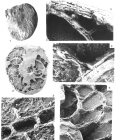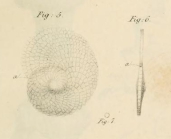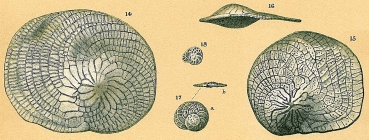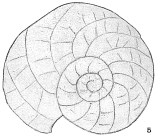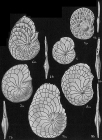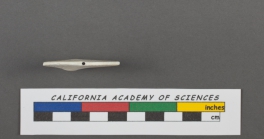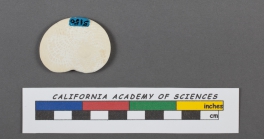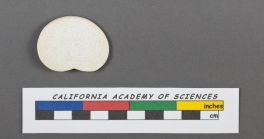Foraminifera taxon details
Heterostegina d'Orbigny, 1826
112238 (urn:lsid:marinespecies.org:taxname:112238)
accepted
Genus
Heterostegina depressa d'Orbigny, 1826 (type by subsequent designation)
Grzybowskia Bieda, 1950 · unaccepted (Subjective junior synonym in...)
Subjective junior synonym in opinion of Loeblich & Tappan, 1987
Heterostegina (Vlerkinella) Eames, Clarke, Banner, Smout & Blow, 1968 · unaccepted (Subjective junior synonym in...)
Subjective junior synonym in opinion of Loeblich & Tappan, 1987
- Subgenus Heterostegina (Vlerkina) Eames, Clarke, Banner, Smout & Blow, 1968 †
- Species Heterostegina (Vlerkina) antillea (Cushman, 1919) †
- Species Heterostegina (Vlerkina) assilinoides (Blanckenhorn, 1890) †
- Species Heterostegina (Vlerkina) borneensis van der Vlerk, 1929 †
- Species Heterostegina (Vlerkina) gajensis Tewari & Singh, 1977 †
- Species Heterostegina (Vlerkina) pleurocentralis (Carter, 1857) †
- Species Heterostegina aequatoria Cole, 1957 †
- Species Heterostegina antillarum d'Orbigny, 1839
- Species Heterostegina apogama Röttger, 1987
- Species Heterostegina armenica (Grigoryan, 1986) †
- Species Heterostegina bantamensis Tan, 1932 †
- Species Heterostegina clathrata Ehrenberg, 1856 †
- Species Heterostegina cubana Cizancourt, 1948 †
- Species Heterostegina curva Möbius, 1880
- Species Heterostegina cycloclypeus Silvestri, 1905 †
- Species Heterostegina depressa d'Orbigny, 1826
- Species Heterostegina duplicamera Cole, 1957 †
- Species Heterostegina gigantea David, 1933 †
- Species Heterostegina glabra Osimo, 1908 †
- Species Heterostegina gracilis Herb, 1978 †
- Species Heterostegina grotriani Reuss, 1866 †
- Species Heterostegina hoffmanni Checchia-Rispoli, 1907 †
- Species Heterostegina indicata Caudri, 1996 †
- Species Heterostegina indusensis Özcan, Ali & Hanif, 2016 †
- Species Heterostegina involutiformis Papp & Küpper, 1954 †
- Species Heterostegina israelskyi Gravell & Hanna, 1937 †
- Species Heterostegina javana Ehrenberg, 1855 †
- Species Heterostegina kohlii Tandon, 1974 †
- Species Heterostegina matteuccii Benedetti, Less, Parente, Pignatti, Cahuzac, Torres-Silva & Buhl, 2017 †
- Species Heterostegina niasi Verbeek, 1896
- Species Heterostegina nigripustula Cole, 1954 †
- Species Heterostegina nuda Keijzer, 1945 †
- Species Heterostegina ocalana Cushman, 1921 †
- Species Heterostegina panamensis Gravell, 1933 †
- Species Heterostegina pusillumbonata Cole, 1954 †
- Species Heterostegina qatarensis Küpper, 1957
- Species Heterostegina rezvaninejadi Kalantari, 1993 †
- Species Heterostegina rupelica Majzon, 1960 †
- Species Heterostegina saipanensis Cole, 1953 †
- Species Heterostegina suborbicularis d'Orbigny in Fornasini, 1904
- Species Heterostegina texana Gravell & Hanna, 1937 †
- Subgenus Heterostegina (Vlerkinella) Eames, Clarke, Banner, Smout & Blow, 1968 accepted as Heterostegina d'Orbigny, 1826 (Subjective junior synonym in opinion of Loeblich & Tappan, 1987)
- Species Heterostegina adamsi Eames & Clarke, 1967 † accepted as Heterostegina ruida Schwager, 1883 † accepted as Daviesina ruida (Schwager, 1883) † (Subjective junior synonym Opinion of Hottinger (2014))
- Species Heterostegina anghiarensis Silvestri, 1907 † accepted as Spiroclypeus anghiarensis (Silvestri, 1907) † (unaccepted > superseded combination, Opinion of Hottinger (1977))
- Species Heterostegina antillea Cushman, 1919 † accepted as Heterostegina (Vlerkina) antillea (Cushman, 1919) † (Opinion of Robinson and Wright (1993))
- Species Heterostegina assilinoides Blanckenhorn, 1890 † accepted as Heterostegina (Vlerkina) assilinoides (Blanckenhorn, 1890) †
- Species Heterostegina assilinoides Blanckenhorn Em. Henson, 1937 † accepted as Heterostegina assilinoides Blanckenhorn, 1890 † accepted as Heterostegina (Vlerkina) assilinoides (Blanckenhorn, 1890) †
- Species Heterostegina barriei Adams & Belford, 1974 † accepted as Planostegina barriei (Adams & Belford, 1974) † (Opinion of Banner and Hodgkinson (1991))
- Species Heterostegina borneensis van der Vlerk, 1929 † accepted as Heterostegina (Vlerkina) borneensis van der Vlerk, 1929 † (Type species of Heterostegina (Vlerkina))
- Species Heterostegina carpatica Uhlig, 1886 † accepted as Spiroclypeus carpaticus (Uhlig, 1886) † (Opinion of Bieda (1957))
- Species Heterostegina complanata Meneghini, 1857 † accepted as Planostegina complanata (Meneghini, 1857) † (Opinion of Banner and Hodgkinson (1991))
- Species Heterostegina costata d'Orbigny, 1846 † accepted as Planostegina costata (d'Orbigny, 1846) † (Type species of Planostegina)
- Species Heterostegina frizzelli Souaya, 1963 † accepted as Planostegina frizzelli (Souaya, 1963) † (Opinion of Banner and Hodgkinson (1991))
- Species Heterostegina giganteoformis Papp, 1978 † accepted as Planostegina giganteoformis (Papp, 1978) † (Opinion of Banner and Hodgkinson (1991))
- Species Heterostegina gomezangulensis Perconig, 1972 † accepted as Planostegina gomezangulensis (Perconig, 1972) † (Opinion of Banner and Hodgkinson (1991))
- Species Heterostegina granulatatesta Papp & Küpper, 1952 † accepted as Planostegina granulatatesta (Papp & Küpper, 1952) † (Opinion of Banner and Hodgkinson (1991))
- Species Heterostegina heterostegina (Silvestri, 1907) † accepted as Planostegina heterostegina (Silvestri, 1907) † (Opinion of Banner and Hodgkinson (1991))
- Species Heterostegina longisepta Zheng, 1979 accepted as Planostegina longisepta (Zheng, 1979) (Opinion of Forderer et al (2018))
- Species Heterostegina margaritacea Majzon, 1960 † accepted as Planostegina margaritacea (Majzon, 1960) † (Opinion of Banner and Hodgkinson (1991))
- Species Heterostegina margaritacea Majzon, 1962 † accepted as Heterostegina margaritacea Majzon, 1960 † accepted as Planostegina margaritacea (Majzon, 1960) † (Erroneously given as a new species Already described earlier)
- Species Heterostegina margaritata Schlumberger, 1902 † accepted as Spiroclypeus margaritatus (Schlumberger, 1902) †
- Species Heterostegina operculinoides Hofker, 1927 accepted as Planostegina operculinoides (Hofker, 1927)
- Species Heterostegina papyracea Seguenza, 1880 † accepted as Planostegina papyracea (Seguenza, 1880) † (Opinion of Banner and Hodgkinson (1991))
- Species Heterostegina pleurocentralis (Carter, 1857) † accepted as Heterostegina (Vlerkina) pleurocentralis (Carter, 1857) † (Opinion of Banner and Hodgkinson (1991))
- Species Heterostegina praecursor Tan, 1930 † accepted as Planostegina praecursor (Tan, 1930) † (Opinion of Banner and Hodgkinson (1991))
- Species Heterostegina ruida Schwager, 1883 † accepted as Daviesina ruida (Schwager, 1883) † (Opinion of Hottinger (2014))
- Species Heterostegina rupelica Majzon, 1962 † accepted as Heterostegina rupelica Majzon, 1960 † (Erroneously given as a new species Already described earlier)
- Species Heterostegina simplex d'Orbigny, 1846 † accepted as Heterostegina costata d'Orbigny, 1846 † accepted as Planostegina costata (d'Orbigny, 1846) † (Subjective junior synonym in opinion of Papp & Schmid (1985))
- Species Heterostegina suborbicularis d'Orbigny, 1826 accepted as Heterostegina suborbicularis d'Orbigny in Fornasini, 1904 (Nomen nudum)
- Species Heterostegina tuberculata Möbius, 1880 accepted as Heterocyclina tuberculata (Möbius, 1880) (Type species of Heterocyclina)
- Species Heterostegina reticulata Rütimeyer, 1850 † represented as Heterostegina reticulata subsp. reticulata Rütimeyer, 1850 † (Opinion of Herb (1978))
marine, brackish, fresh, terrestrial
recent + fossil
Orbigny, A. D. d'. (1826). Tableau méthodique de la classe des Céphalopodes. <em>Annales des Sciences Naturelles.</em> vol. 7: 96-169, 245-314., available online at http://biodiversitylibrary.org/page/5753959
page(s): p. 305 [details]
page(s): p. 305 [details]
Diagnosis Test involute to evolute, centrally thickened, megalospheric proloculus followed by up to sixteen operculinoid and unfolded...
Diagnosis Test involute to evolute, centrally thickened, megalospheric proloculus followed by up to sixteen operculinoid and unfolded septa, larger and relatively rare microspheric test with about thirty unfolded septa, then with chamberlets formed by complete secondary septa produced by folds of the septal flap, no communication between adjacent chamberlets of the same chamber, marginal cord consists of an anastomosing bundle of canals in the peripheral band that are continuous with those in the spiral septum of earlier whorls, intraseptal canals formed from part of former marginal canals as new chamber is added, and connect the marginal canals of successive whorls, secondary sutural canals in the septula forming the chamberlets connect successive sutural canals, and those in peripheral position may lead into the marginal canals, apertures of proloculus and early undivided chambers form the primary stolons or apertural or foraminal tubes, later chambers and chamberlets of a single chamber connected by radial stolons or tubes and may also have annular stolons or tangential tubes, so-called because of their position, Y-shaped supplementary stolons occur at the distal tip of the secondary septula in the median plane, smaller connections occur between the chamber lumen and peripheral canals of the final whorl and spiralling canals of the underlying whorl and may also lead to the intraseptal canals, canal system opens through small branches or trabeculae into the relatively large pores or openings of the marginal, septal and secondary septal canals and to the exterior; wall calcareous, finely perforate, chambers and stolons with organic lining but none present in the canal system, up to six interseptal pillars present on the lateral chamberlet walls; openings of the canal system along the periphery may serve for ingestion of nutrients, waste excretion, and exit of the protoplasm from the test at the time of sexual reproduction; live individuals have endosymbiotic diatoms whose photosynthesis provides nutrition for the host; asexual reproduction by multiple fission of protoplasm that earlier had streamed outside the test, producing 100 to over 1,000 young that obtain symbionts from the parent protoplasm, rarely some residual protoplasm remains in the parent cell, continues to grow, and later reproduces a second time; at gamogony thousands of 120 µm ovoid biflagellate gametes are produced. U. Eocene to Holocene; cosmopolitan, tropical to temperate Atlantic, Pacific, and Indian Oceans. (Loeblich & Tappan, 1987, Foraminiferal Genera and Their Classification) [details]
Hayward, B.W.; Le Coze, F.; Vachard, D.; Gross, O. (2021). World Foraminifera Database. Heterostegina d'Orbigny, 1826. Accessed at: http://www.marinespecies.org/foraminifera/aphia.php?p=taxdetails&id=112238 on 2025-07-16
Date
action
by
2006-09-13 06:47:38Z
changed
Martinez, Olga
original description
Orbigny, A. D. d'. (1826). Tableau méthodique de la classe des Céphalopodes. <em>Annales des Sciences Naturelles.</em> vol. 7: 96-169, 245-314., available online at http://biodiversitylibrary.org/page/5753959
page(s): p. 305 [details]
original description (of Heterostegina (Vlerkinella) Eames, Clarke, Banner, Smout & Blow, 1968) Eames, F. E.; Clarke, W. J.; Banner, F. T.; Smout, A. H.; Blow, W. H. (1968). Some larger foraminifera from the Tertiary of Central America. <em>Palaeontology.</em> 11: 283-305., available online at https://www.palass.org/sites/default/files/media/publications/palaeontology/volume_11/vol11_part2_pp283-305.pdf
page(s): p. 291 [details] Available for editors [request]
[request]
original description (of Grzybowskia Bieda, 1950) Bieda, E. (1950). O nowych i mało znanych otwornicach z fliszu Karpat Polskich - Sur quelques foraminifères nouveaux ou peu connus du flysch des Karpates Polonaises. <em>Rocznik Polskiego Towarzystwa Geologicznego.</em> 18: 151-179., available online at https://geojournals.pgi.gov.pl/asgp/article/view/10982/9473
page(s): p. 151 (Polish), 167 (French) [details] Available for editors [request]
[request]
basis of record Gross, O. (2001). Foraminifera, <B><I>in</I></B>: Costello, M.J. <i>et al.</i> (Ed.) (2001). <i>European register of marine species: a check-list of the marine species in Europe and a bibliography of guides to their identification. Collection Patrimoines Naturels,</i> 50: pp. 60-75 (look up in IMIS) [details]
additional source Neave, Sheffield Airey. (1939-1996). Nomenclator Zoologicus vol. 1-10 Online. <em>[Online Nomenclator Zoologicus at Checklistbank. Ubio link has gone].</em> , available online at https://www.checklistbank.org/dataset/126539/about [details]
additional source Loeblich, A. R.; Tappan, H. (1987). Foraminiferal Genera and their Classification. Van Nostrand Reinhold Company, New York. 970pp., available online at https://books.google.pt/books?id=n_BqCQAAQBAJ [details] Available for editors [request]
[request]
page(s): p. 305 [details]
original description (of Heterostegina (Vlerkinella) Eames, Clarke, Banner, Smout & Blow, 1968) Eames, F. E.; Clarke, W. J.; Banner, F. T.; Smout, A. H.; Blow, W. H. (1968). Some larger foraminifera from the Tertiary of Central America. <em>Palaeontology.</em> 11: 283-305., available online at https://www.palass.org/sites/default/files/media/publications/palaeontology/volume_11/vol11_part2_pp283-305.pdf
page(s): p. 291 [details] Available for editors
original description (of Grzybowskia Bieda, 1950) Bieda, E. (1950). O nowych i mało znanych otwornicach z fliszu Karpat Polskich - Sur quelques foraminifères nouveaux ou peu connus du flysch des Karpates Polonaises. <em>Rocznik Polskiego Towarzystwa Geologicznego.</em> 18: 151-179., available online at https://geojournals.pgi.gov.pl/asgp/article/view/10982/9473
page(s): p. 151 (Polish), 167 (French) [details] Available for editors
basis of record Gross, O. (2001). Foraminifera, <B><I>in</I></B>: Costello, M.J. <i>et al.</i> (Ed.) (2001). <i>European register of marine species: a check-list of the marine species in Europe and a bibliography of guides to their identification. Collection Patrimoines Naturels,</i> 50: pp. 60-75 (look up in IMIS) [details]
additional source Neave, Sheffield Airey. (1939-1996). Nomenclator Zoologicus vol. 1-10 Online. <em>[Online Nomenclator Zoologicus at Checklistbank. Ubio link has gone].</em> , available online at https://www.checklistbank.org/dataset/126539/about [details]
additional source Loeblich, A. R.; Tappan, H. (1987). Foraminiferal Genera and their Classification. Van Nostrand Reinhold Company, New York. 970pp., available online at https://books.google.pt/books?id=n_BqCQAAQBAJ [details] Available for editors
 Present
Present  Inaccurate
Inaccurate  Introduced: alien
Introduced: alien  Containing type locality
Containing type locality
From editor or global species database
Diagnosis Test involute to evolute, centrally thickened, megalospheric proloculus followed by up to sixteen operculinoid and unfolded septa, larger and relatively rare microspheric test with about thirty unfolded septa, then with chamberlets formed by complete secondary septa produced by folds of the septal flap, no communication between adjacent chamberlets of the same chamber, marginal cord consists of an anastomosing bundle of canals in the peripheral band that are continuous with those in the spiral septum of earlier whorls, intraseptal canals formed from part of former marginal canals as new chamber is added, and connect the marginal canals of successive whorls, secondary sutural canals in the septula forming the chamberlets connect successive sutural canals, and those in peripheral position may lead into the marginal canals, apertures of proloculus and early undivided chambers form the primary stolons or apertural or foraminal tubes, later chambers and chamberlets of a single chamber connected by radial stolons or tubes and may also have annular stolons or tangential tubes, so-called because of their position, Y-shaped supplementary stolons occur at the distal tip of the secondary septula in the median plane, smaller connections occur between the chamber lumen and peripheral canals of the final whorl and spiralling canals of the underlying whorl and may also lead to the intraseptal canals, canal system opens through small branches or trabeculae into the relatively large pores or openings of the marginal, septal and secondary septal canals and to the exterior; wall calcareous, finely perforate, chambers and stolons with organic lining but none present in the canal system, up to six interseptal pillars present on the lateral chamberlet walls; openings of the canal system along the periphery may serve for ingestion of nutrients, waste excretion, and exit of the protoplasm from the test at the time of sexual reproduction; live individuals have endosymbiotic diatoms whose photosynthesis provides nutrition for the host; asexual reproduction by multiple fission of protoplasm that earlier had streamed outside the test, producing 100 to over 1,000 young that obtain symbionts from the parent protoplasm, rarely some residual protoplasm remains in the parent cell, continues to grow, and later reproduces a second time; at gamogony thousands of 120 µm ovoid biflagellate gametes are produced. U. Eocene to Holocene; cosmopolitan, tropical to temperate Atlantic, Pacific, and Indian Oceans. (Loeblich & Tappan, 1987, Foraminiferal Genera and Their Classification) [details]
